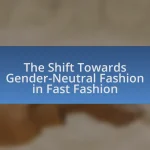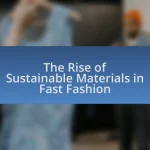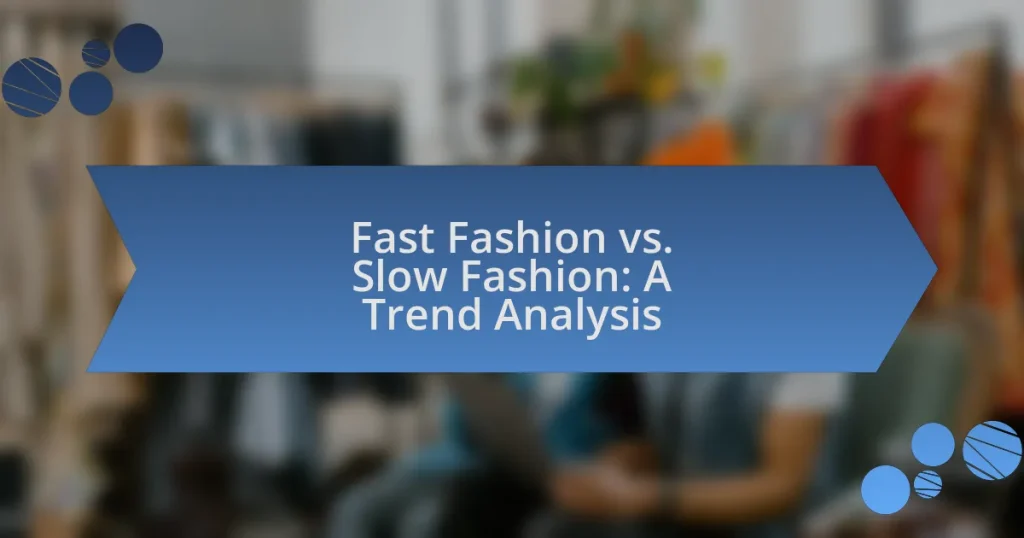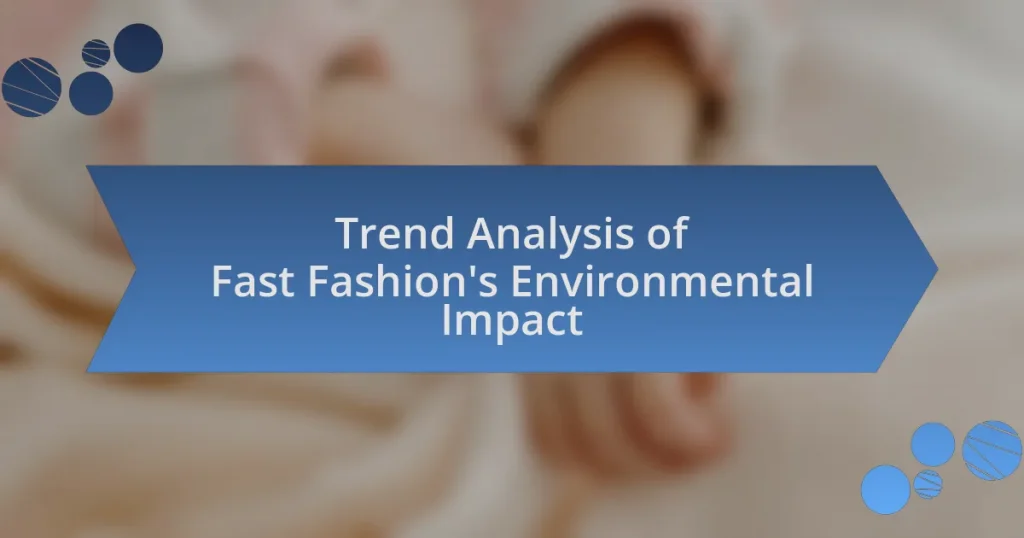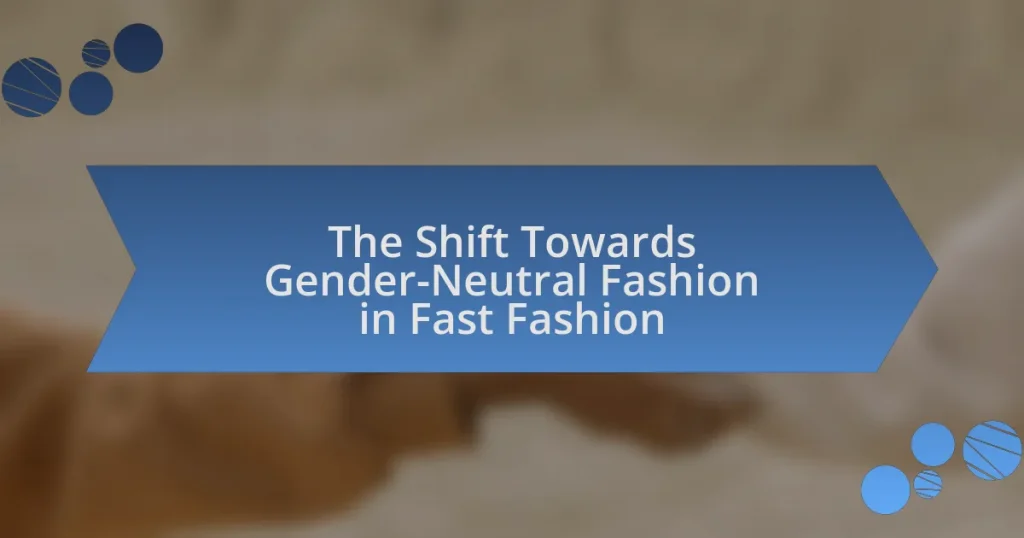Fast fashion is characterized by the rapid production of inexpensive clothing to meet current trends, leading to significant environmental and ethical issues. In contrast, slow fashion emphasizes sustainability, quality, and ethical production practices, encouraging consumers to invest in durable garments. The article explores the differences in production processes, environmental impacts, and labor conditions associated with both fast and slow fashion, highlighting the growing consumer demand for sustainable practices and the cultural shift towards mindful consumption. It also discusses the challenges faced by slow fashion brands in competing with fast fashion pricing and the practical steps consumers can take to support sustainable fashion choices.

What is Fast Fashion and Slow Fashion?
Fast fashion refers to the rapid production of inexpensive clothing to meet the latest trends, characterized by quick turnaround times and low prices, often resulting in significant environmental and ethical concerns. In contrast, slow fashion emphasizes quality, sustainability, and ethical production practices, encouraging consumers to invest in fewer, higher-quality garments that last longer. The fast fashion industry has grown significantly, with brands like Zara and H&M leading the market, while slow fashion advocates, such as Eileen Fisher and Patagonia, promote environmentally friendly practices and fair labor conditions.
How do Fast Fashion and Slow Fashion differ in their production processes?
Fast fashion and slow fashion differ significantly in their production processes. Fast fashion emphasizes rapid production cycles, often utilizing inexpensive materials and labor to quickly bring trendy designs to market, resulting in high volumes of clothing that are frequently updated. In contrast, slow fashion prioritizes quality over quantity, focusing on sustainable materials, ethical labor practices, and longer production timelines, which allows for more thoughtful design and craftsmanship. This distinction is evident in the fact that fast fashion brands can produce new collections in as little as two weeks, while slow fashion brands may take several months to develop a single collection, reflecting a commitment to sustainability and ethical practices.
What are the key characteristics of Fast Fashion production?
The key characteristics of Fast Fashion production include rapid design and manufacturing processes, low-cost materials, and a focus on high turnover of styles. Fast Fashion brands quickly translate runway trends into affordable clothing, often producing new collections every few weeks. This approach relies on outsourcing production to countries with lower labor costs, enabling brands to maintain competitive pricing. Additionally, Fast Fashion emphasizes consumer demand for immediacy, leading to a culture of disposable fashion where garments are worn only a few times before being discarded. This model contributes to significant environmental impacts, including waste and pollution, as the industry generates approximately 92 million tons of textile waste annually.
What are the key characteristics of Slow Fashion production?
The key characteristics of Slow Fashion production include sustainability, ethical labor practices, and a focus on quality over quantity. Sustainability in Slow Fashion emphasizes the use of eco-friendly materials and processes that minimize environmental impact, such as organic cotton and recycled fabrics. Ethical labor practices ensure fair wages and safe working conditions for garment workers, contrasting sharply with the exploitative practices often found in Fast Fashion. Additionally, Slow Fashion prioritizes high-quality craftsmanship, resulting in durable products designed to last, which reduces waste and encourages mindful consumption. These characteristics collectively promote a more responsible and conscious approach to fashion production.
Why has Fast Fashion become popular in recent years?
Fast fashion has become popular in recent years primarily due to its ability to quickly deliver trendy clothing at affordable prices. Retailers like Zara and H&M have capitalized on consumer demand for new styles, introducing collections that reflect the latest fashion trends within weeks of their emergence on runways. This rapid production cycle is supported by advancements in supply chain management and manufacturing technologies, allowing brands to respond swiftly to market trends. Additionally, the rise of social media platforms has amplified the visibility of fashion trends, encouraging consumers to seek out the latest styles frequently. According to a report by McKinsey & Company, the global fast fashion market was valued at approximately $35 billion in 2021, highlighting its significant growth and consumer appeal.
What role does consumer demand play in the rise of Fast Fashion?
Consumer demand is a primary driver of the rise of Fast Fashion, as it creates a continuous need for inexpensive, trendy clothing. This demand is fueled by consumers’ desire for new styles at a rapid pace, leading brands to produce collections more frequently, often on a weekly basis. According to a report by McKinsey & Company, the global apparel market is projected to reach $2.25 trillion by 2025, largely due to the increasing consumer appetite for affordable fashion. This insatiable demand encourages retailers to prioritize speed and cost-efficiency in their production processes, resulting in the proliferation of Fast Fashion brands that cater to these consumer preferences.
How do marketing strategies influence Fast Fashion trends?
Marketing strategies significantly influence Fast Fashion trends by creating a sense of urgency and exclusivity among consumers. Brands utilize tactics such as limited-time offers, influencer partnerships, and social media campaigns to drive immediate purchases and foster a perception of scarcity. For instance, companies like Zara and H&M frequently release new collections, often within weeks, which encourages consumers to buy quickly to stay on-trend. Research indicates that 60% of consumers feel pressured to purchase items quickly due to marketing tactics, reinforcing the rapid turnover characteristic of Fast Fashion. This strategic manipulation of consumer behavior directly shapes the trends within the Fast Fashion industry.
What are the environmental impacts of Fast Fashion compared to Slow Fashion?
Fast fashion significantly harms the environment compared to slow fashion. Fast fashion contributes to pollution through the production of cheap, low-quality garments that are often discarded after a few uses, leading to increased textile waste. According to the Ellen MacArthur Foundation, the fashion industry is responsible for 10% of global carbon emissions, with fast fashion brands contributing disproportionately due to their rapid production cycles and high turnover rates.
In contrast, slow fashion emphasizes sustainability by promoting high-quality, durable clothing that is made to last, reducing the frequency of purchases and waste. Slow fashion practices often include the use of eco-friendly materials and ethical production methods, which minimize environmental impact. Research from the Journal of Cleaner Production indicates that sustainable fashion practices can reduce carbon emissions by up to 80% compared to conventional fast fashion methods.
Overall, the environmental impacts of fast fashion are characterized by high waste generation and significant carbon emissions, while slow fashion offers a more sustainable alternative through responsible consumption and production practices.
How does Fast Fashion contribute to pollution and waste?
Fast fashion contributes to pollution and waste primarily through its rapid production cycles and disposable nature. The industry generates approximately 92 million tons of textile waste annually, with a significant portion ending up in landfills. Additionally, the production process involves the use of toxic chemicals and dyes, which contaminate water sources; for instance, the fashion industry is responsible for about 20% of global wastewater. Furthermore, fast fashion’s reliance on synthetic fibers, such as polyester, leads to microplastic pollution, with an estimated 500,000 tons of microfibers entering the oceans each year. These factors collectively highlight the detrimental environmental impact of fast fashion on pollution and waste.
What sustainable practices are associated with Slow Fashion?
Sustainable practices associated with Slow Fashion include the use of eco-friendly materials, ethical labor practices, and a focus on quality over quantity. Eco-friendly materials, such as organic cotton and recycled fabrics, reduce environmental impact by minimizing chemical use and waste. Ethical labor practices ensure fair wages and safe working conditions for garment workers, promoting social sustainability. Additionally, Slow Fashion emphasizes creating durable, timeless pieces that encourage consumers to buy less frequently, thereby reducing overall consumption and waste. This approach contrasts sharply with Fast Fashion, which often prioritizes rapid production and low costs at the expense of environmental and social responsibility.
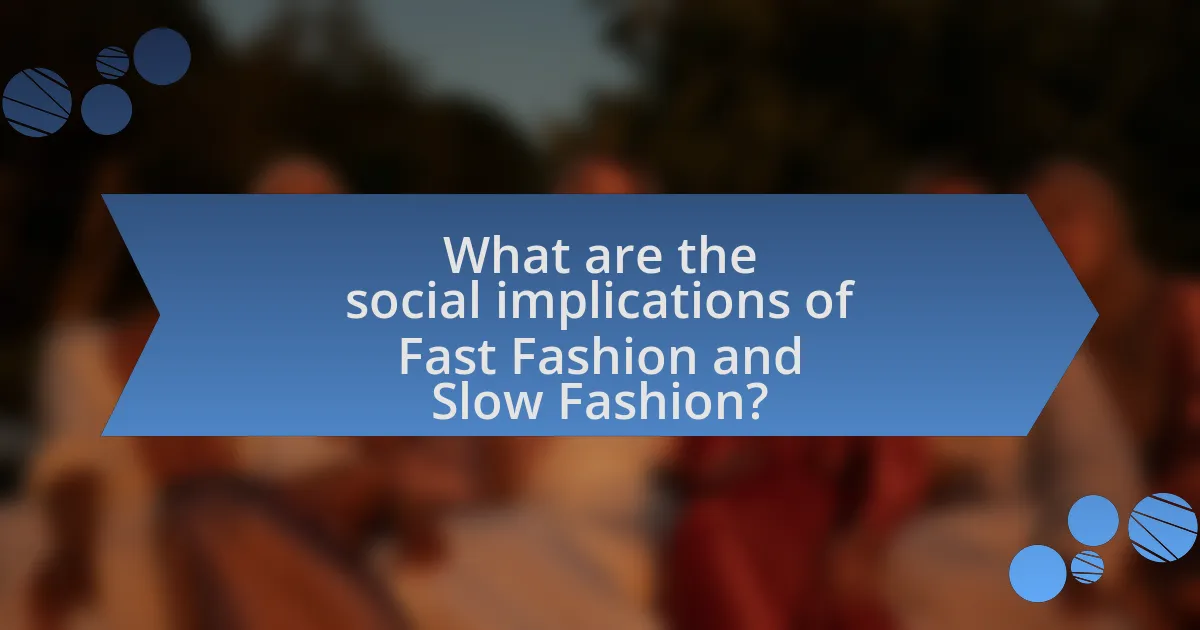
What are the social implications of Fast Fashion and Slow Fashion?
Fast fashion promotes a culture of consumerism and disposability, leading to negative social implications such as exploitation of labor and environmental degradation. Workers in fast fashion supply chains often face poor working conditions, low wages, and lack of rights, as evidenced by reports from organizations like the International Labour Organization, which highlights that many garment workers earn less than the living wage. In contrast, slow fashion emphasizes sustainability and ethical production, fostering social responsibility and community engagement. This approach supports fair labor practices and encourages consumers to value quality over quantity, as noted in studies by the Fashion Institute of Technology, which indicate that slow fashion can enhance social awareness and promote a more equitable industry.
How does Fast Fashion affect labor conditions in the garment industry?
Fast fashion negatively impacts labor conditions in the garment industry by promoting exploitative practices such as low wages, long working hours, and unsafe working environments. The demand for rapid production cycles forces manufacturers to cut costs, often resulting in the use of sweatshops where workers face harsh conditions. For instance, a report by the International Labour Organization indicates that garment workers in fast fashion supply chains often earn less than the minimum wage and work in facilities lacking basic safety measures. This systemic exploitation is driven by the industry’s focus on maximizing profit margins at the expense of workers’ rights and well-being.
What are the common labor rights violations in Fast Fashion production?
Common labor rights violations in fast fashion production include low wages, excessive working hours, unsafe working conditions, and lack of union representation. Workers in fast fashion factories often receive wages below the living wage, making it difficult to meet basic needs. Reports indicate that employees frequently work more than 60 hours a week without overtime pay, violating labor laws in many countries. Additionally, many factories lack proper safety measures, leading to hazardous environments that can result in injuries. Furthermore, workers are often denied the right to organize or join unions, limiting their ability to advocate for better conditions. These violations are documented in various reports, including those from organizations like Human Rights Watch and the International Labour Organization, which highlight systemic issues within the industry.
How does Slow Fashion promote ethical labor practices?
Slow Fashion promotes ethical labor practices by prioritizing fair wages and safe working conditions for garment workers. This approach emphasizes transparency in the supply chain, ensuring that brands are accountable for the treatment of their workers. For instance, Slow Fashion brands often collaborate with local artisans and manufacturers, which fosters direct relationships and fair compensation. Research indicates that brands adhering to Slow Fashion principles report higher worker satisfaction and lower turnover rates, as they invest in the well-being of their employees. This commitment to ethical labor practices contrasts sharply with the exploitative conditions often found in Fast Fashion, where cost-cutting measures frequently lead to worker exploitation.
What cultural shifts are associated with the rise of Slow Fashion?
The rise of Slow Fashion is associated with a cultural shift towards sustainability, mindfulness, and ethical consumerism. This movement reflects a growing awareness of the environmental and social impacts of fast fashion, leading consumers to prioritize quality over quantity, and to seek out brands that emphasize transparency and fair labor practices. For instance, a 2020 survey by McKinsey & Company found that 67% of consumers consider the use of sustainable materials important when making fashion purchases, indicating a significant shift in consumer values towards eco-consciousness. Additionally, Slow Fashion promotes a return to craftsmanship and local production, fostering a deeper connection between consumers and the products they buy, which contrasts sharply with the mass production ethos of fast fashion.
How does Slow Fashion encourage mindful consumption?
Slow Fashion encourages mindful consumption by promoting the idea of quality over quantity, urging consumers to invest in durable, ethically produced garments rather than fast, disposable fashion. This approach fosters awareness of the environmental and social impacts of clothing production, encouraging individuals to consider the lifecycle of their purchases. Research indicates that Slow Fashion can reduce waste and carbon footprints, as consumers are motivated to buy less frequently and choose sustainable options, ultimately leading to a more responsible consumption pattern.
What role does community play in the Slow Fashion movement?
Community plays a crucial role in the Slow Fashion movement by fostering collaboration, education, and support among individuals and brands committed to sustainable practices. This collective effort encourages consumers to prioritize ethical production, reduce waste, and appreciate craftsmanship, which are core principles of Slow Fashion. For instance, community-driven initiatives like local clothing swaps and workshops promote awareness and engagement, allowing participants to share knowledge about sustainable materials and production methods. Research indicates that communities engaged in Slow Fashion practices can significantly influence consumer behavior, leading to a more sustainable fashion ecosystem.
How do consumer attitudes towards Fast Fashion and Slow Fashion differ?
Consumer attitudes towards Fast Fashion and Slow Fashion differ significantly in terms of sustainability and value perception. Fast Fashion consumers often prioritize low prices and trendy styles, leading to a higher turnover of clothing and a disregard for environmental impacts. In contrast, Slow Fashion consumers value quality, sustainability, and ethical production, often willing to pay more for garments that are environmentally friendly and made to last. Research indicates that 66% of consumers are willing to pay more for sustainable brands, highlighting a growing preference for Slow Fashion principles.
What factors influence consumer choices between Fast Fashion and Slow Fashion?
Consumer choices between Fast Fashion and Slow Fashion are influenced by factors such as price, quality, environmental impact, and brand values. Price plays a significant role, as Fast Fashion typically offers lower-cost items, making it more accessible to a broader audience. In contrast, Slow Fashion emphasizes higher quality and sustainability, often resulting in higher prices that appeal to consumers willing to invest in ethical practices.
Quality is another critical factor; Fast Fashion items may lack durability, leading consumers to seek Slow Fashion alternatives that promise longevity. Environmental impact increasingly affects consumer decisions, with many individuals prioritizing sustainable practices and eco-friendly materials associated with Slow Fashion. Additionally, brand values resonate with consumers; those who align with ethical consumption are more likely to choose Slow Fashion brands that advocate for fair labor practices and environmental stewardship.
Research indicates that 66% of global consumers are willing to pay more for sustainable brands, highlighting the growing importance of these factors in consumer decision-making.
How can education impact consumer awareness of fashion sustainability?
Education significantly enhances consumer awareness of fashion sustainability by providing knowledge about the environmental and social impacts of the fashion industry. When consumers are educated on issues such as textile waste, resource depletion, and labor practices, they are more likely to make informed purchasing decisions that favor sustainable brands. Research indicates that consumers who receive education on sustainability are 50% more likely to choose eco-friendly products, as highlighted in a study by the Journal of Consumer Research. This increased awareness leads to a demand for transparency and ethical practices in the fashion industry, ultimately driving brands to adopt more sustainable practices.

What are the future trends in Fast Fashion and Slow Fashion?
Future trends in fast fashion include increased reliance on technology for rapid production and supply chain optimization, while slow fashion is expected to gain traction through sustainable practices and consumer demand for ethical production. Fast fashion brands are adopting AI and data analytics to predict trends and streamline inventory, leading to quicker turnaround times. In contrast, slow fashion emphasizes quality over quantity, with a focus on eco-friendly materials and transparent sourcing, reflecting a shift in consumer preferences towards sustainability. This trend is supported by a 2021 McKinsey report indicating that 67% of consumers consider sustainability when making a purchase.
How is technology influencing the evolution of Fast Fashion?
Technology is significantly influencing the evolution of fast fashion by enabling rapid design, production, and distribution processes. Advanced software tools and algorithms allow brands to analyze consumer trends in real-time, leading to quicker turnaround times for new collections. For instance, companies like Zara utilize data analytics to track customer preferences and adjust inventory accordingly, resulting in a 15-day cycle from design to retail. Additionally, automation in manufacturing and logistics streamlines operations, reducing costs and increasing efficiency. The integration of e-commerce platforms further accelerates sales, allowing brands to reach global markets instantly. These technological advancements collectively drive the fast fashion model, emphasizing speed and responsiveness to consumer demand.
What innovations are being adopted in Fast Fashion production?
Fast Fashion production is adopting innovations such as automated manufacturing processes, sustainable materials, and digital design technologies. Automated manufacturing, including robotics and AI, enhances efficiency and reduces labor costs, allowing brands to quickly respond to fashion trends. The use of sustainable materials, like recycled fabrics and organic cotton, addresses environmental concerns and meets consumer demand for eco-friendly products. Digital design technologies, including 3D modeling and virtual fitting rooms, streamline the design process and improve customer experience by enabling rapid prototyping and personalized shopping. These innovations collectively contribute to the agility and sustainability of Fast Fashion, aligning with market trends and consumer preferences.
How can technology support sustainable practices in Slow Fashion?
Technology can support sustainable practices in Slow Fashion by enabling efficient resource management and promoting transparency in supply chains. For instance, digital tools like blockchain can track the origin of materials, ensuring ethical sourcing and reducing waste. Additionally, 3D printing technology allows for on-demand production, minimizing overproduction and excess inventory, which are significant issues in the fashion industry. According to a report by McKinsey & Company, implementing such technologies can lead to a reduction in carbon emissions by up to 30% in the fashion sector. This demonstrates that technology not only enhances sustainability but also aligns with the core principles of Slow Fashion by fostering responsible consumption and production practices.
What are the potential challenges facing Slow Fashion in the market?
Slow Fashion faces several potential challenges in the market, primarily including consumer awareness, pricing, and scalability. Consumer awareness is limited, as many shoppers remain unaware of the environmental and ethical benefits of Slow Fashion compared to Fast Fashion. Pricing presents a significant barrier, as Slow Fashion items often cost more due to sustainable materials and ethical labor practices, making them less accessible to price-sensitive consumers. Scalability is another challenge, as Slow Fashion brands struggle to compete with the mass production capabilities of Fast Fashion, which can lead to lower prices and higher market penetration. These challenges hinder the growth and acceptance of Slow Fashion in a market dominated by Fast Fashion trends.
How can Slow Fashion brands compete with Fast Fashion pricing?
Slow Fashion brands can compete with Fast Fashion pricing by emphasizing quality, sustainability, and ethical production, which justify higher price points. By focusing on durable materials and craftsmanship, Slow Fashion brands create products that last longer, reducing the need for frequent replacements. For instance, a study by the Ellen MacArthur Foundation highlights that extending the life of clothing by just nine months can reduce carbon, water, and waste footprints by 20-30%. Additionally, Slow Fashion brands can leverage direct-to-consumer sales models to minimize costs associated with middlemen, allowing for competitive pricing while maintaining ethical standards.
What strategies can Slow Fashion adopt to increase visibility and reach?
Slow Fashion can increase visibility and reach by leveraging social media platforms to engage with consumers directly. By utilizing visually-driven platforms like Instagram and TikTok, Slow Fashion brands can showcase their sustainable practices, unique designs, and storytelling, which resonate with eco-conscious consumers. Research indicates that 54% of social media users use these platforms to discover new products, highlighting the effectiveness of social media in expanding brand awareness. Additionally, collaborating with influencers who align with Slow Fashion values can amplify messaging and attract a broader audience, as influencer marketing has been shown to yield an average return of $5.78 for every dollar spent.
What practical steps can consumers take to support Slow Fashion?
Consumers can support Slow Fashion by prioritizing quality over quantity in their clothing purchases. This involves choosing garments made from sustainable materials, which often have a lower environmental impact compared to fast fashion alternatives. Additionally, consumers can buy from brands that are transparent about their production processes and labor practices, ensuring ethical standards are upheld. Supporting local artisans and small businesses also contributes to the Slow Fashion movement, as it fosters community economies and reduces carbon footprints associated with shipping. Furthermore, consumers can practice mindful consumption by buying second-hand clothing, which extends the life cycle of garments and reduces waste. According to a report by the Ellen MacArthur Foundation, extending the life of clothing by just nine months can reduce carbon, water, and waste footprints by around 20-30%.
How can consumers identify and choose Slow Fashion brands?
Consumers can identify and choose Slow Fashion brands by looking for transparency in production processes, sustainable materials, and ethical labor practices. Slow Fashion brands typically provide detailed information about their sourcing, manufacturing, and labor conditions, often highlighting certifications such as Fair Trade or GOTS (Global Organic Textile Standard). Additionally, consumers should seek brands that prioritize quality over quantity, offering timeless designs that encourage longevity rather than fast trends. Research indicates that Slow Fashion brands often engage in environmentally friendly practices, such as using organic or recycled materials, which can be verified through product labels or brand websites.
What are some tips for building a sustainable wardrobe?
To build a sustainable wardrobe, prioritize quality over quantity by selecting durable, timeless pieces that can withstand trends and wear. Investing in high-quality garments reduces the need for frequent replacements, thereby minimizing waste. Additionally, opt for clothing made from sustainable materials, such as organic cotton or recycled fabrics, which have a lower environmental impact compared to conventional materials. Supporting ethical brands that prioritize fair labor practices and transparency in their supply chains further contributes to sustainability. Lastly, consider second-hand shopping, as it extends the life cycle of clothing and reduces demand for new production, aligning with sustainable practices.


